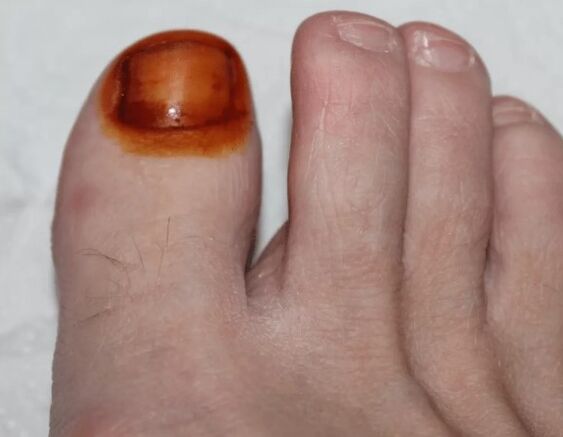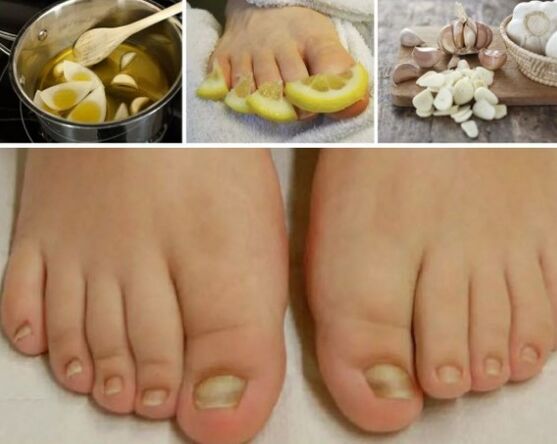According to statistics, almost half of all calls to a dermatologist, in one way or another, is associated with fungal diseases. You can take the infection when you visit the pool, sauna, visit the beach, or visit the lord's slippers.
Learn about how to recognize the fungus of the toenails without scraping and the use of other diagnostic methods - the symptoms of the manifestations of onychomycosis of the original and chronic stages of the disease.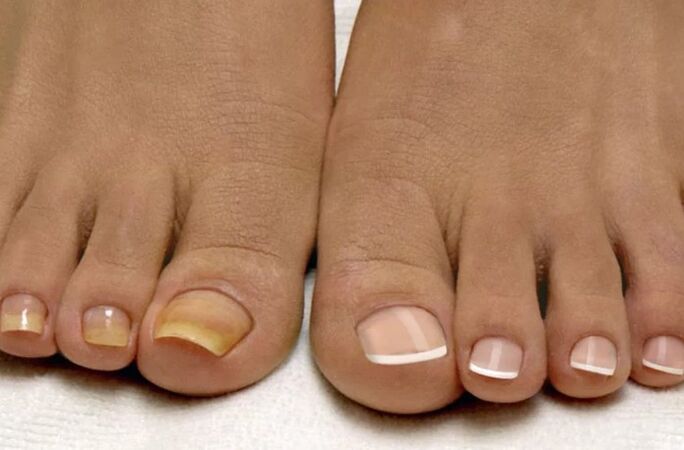
Many do not even suspect that banal sweating of the feet, accompanied by an unpleasant odor that more than half of the population of our planet suffers, is one of the main symptoms of nail fungus. This disease is at risk of getting sick, which at least slightly neglects personal hygiene.
Nail fungus is found everywhere, especially in public areas. And the worse is that nail fungus is a rather insidious disease: its treatment is long and not always successful, as mycosis is prone to relapses.
In order to recognize the disease on time and start treating it, you need to know all the signs of fungus on the legs.
The infection is caused by parasitic fungi. The ideal environment for their reproduction and development is the increased humidity in combination with a warm atmosphere. It is generally accepted that the main places where the risk of infection with nail fungus is high are bathrooms, saunas, water parks, swimming pools, manicure salons, etc.
However, statistics completely refute these claims: the nail fungus can be taken at home through common things (towels, shoes, clothes, carpets, shower or bath) if one of the family members already has this problem or at a party, for example, through slippers, kindly offered by the owner (and he may even suspect the presence of illness).
But what factors affect the development of a fungal disease? Such main points are noted, leading to onychomycosis infection: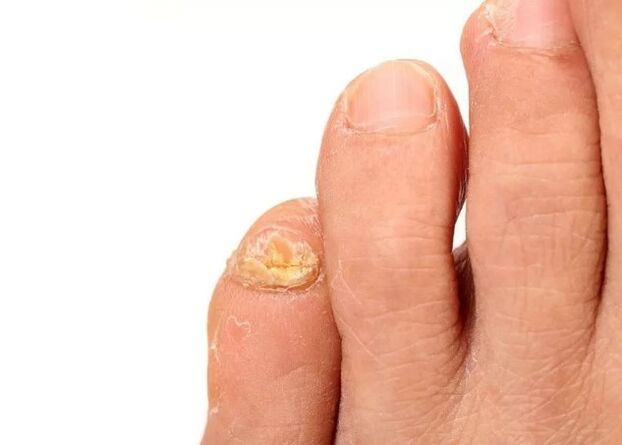
To protect yourself at least partially, you need to use your things exclusively, carefully treat the bath and bathe with antiseptics, use a personal cloth, regularly clean and wash the carpets, disinfect the shoes. And in order not to miss the moment favorable to the treatment of mycosis (after all, everyone knows that therapy is most effective in the initial stage of the development of the disease), you need to know the first signs of nail fungus.
Once you have recognized the first signs of nail fungus, you should contact a specialist immediately who will prescribe the optimal treatment regimen.
3 types of onychomycosis are determined, each of which manifests itself in its own signs.
You can determine the presence of a fungus on your nails, but only a specialist can make an accurate diagnosis. To do this, you need to visit the clinic, take to analyze the scraping of an inflammatory nail or skin located around it. In addition, the dermatologist prescribes a microscopic or cultural study.
The success of treating nail fungus depends on how properly the pathogen is diagnosed. This is explained by the fact that the disease causes not one type of fungus, and several and each of them is sensitive to certain medicines. That is, if one type of fungus is resistant to one medicine, then the other pathogen dies of this product.
More often, nail fungus causes: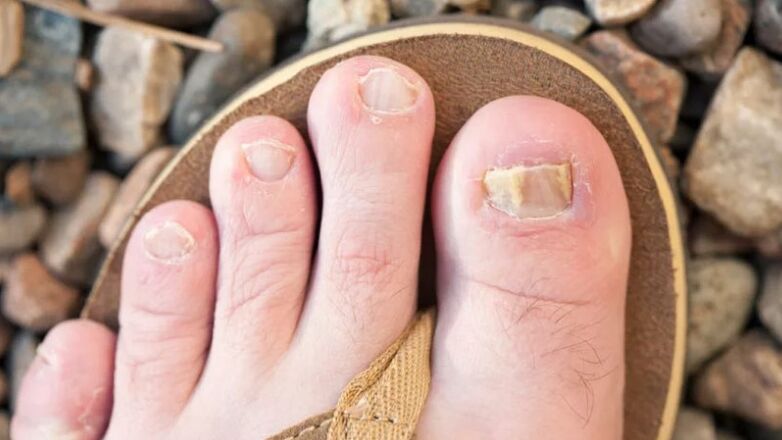
If the cause of the nail fungus becomes yeast, then it is almost impossible to identify the disease immediately. The signs of the fungus on the toenails in this case are the following (they appear after a long period of time): nail peeling and slight itching of the skin near the nail (itching may be absent). Failed yeast infection occurs in 4-4, 5% of cases.
Dermatophytes affect a person's nails much more than the previous pathogen - this is 94, 5% of all cases of nail infection with a fungus. Dermatophytes are of three types, each of them manifests in different ways:
The last type of mushroom is mildew. His pathogen is mold. This disease is found in only 1% of cases. The fungus of this species develops more often in HIV-infected people.
Often, at the onset of the disease, there are no obvious signs of fungal damage to the nails. However, to be careful, you can notice some changes in the nail structure and its appearance.
As mentioned earlier, longitudinal or round whitish spots can appear on the nails, the nail can become similar to the wave, while its smoothness and shine are lost.
By progressing, the disease more and more destroys the nail plate: first its shadow changes, then the surface of the nail becomes flaky, it thickens or thickens, relaxes, breaks. The color of the nail depends on which type of fungus became the cause of the infection.
In addition to the main signs of onychomycosis, there are others: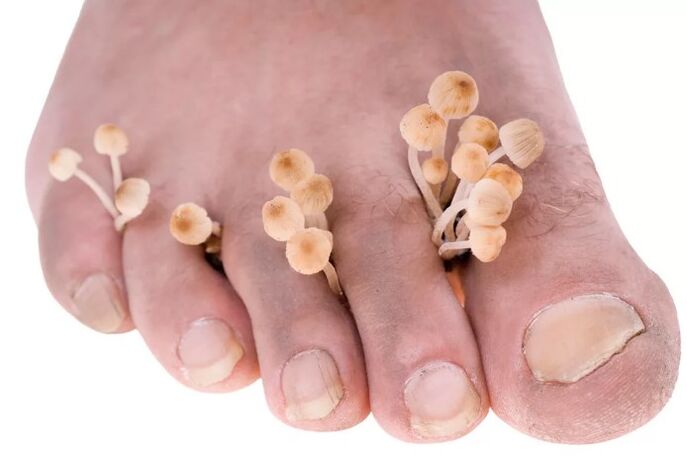
Any deviation in the appearance of the toenails should be alert as this may indicate the development of nail fungus. The first action in this case is a trip to a dermatologist who will confirm or disprove your fears. If this is not done immediately, the disease will progress.
At first glance, there is nothing wrong with this disease. However, in addition to purely aesthetic problems and discomfort, the sponge can cause serious complications, to the purulent infection of the affected areas and even the development of gangrene.
Therefore, do not tighten yourself with treatment, take measures at once as the disease is detected.
Every third person on Earth has encountered a problem such as stratification and squeezing nails, blurring the plate - this is onychomycosis. The disease affects different age groups. Foot fungus (the photos are presented below), quickly spread and adapts to new conditions. We will look more in detail the main factors for the occurrence, types and methods of treating fungi.
Onychomycosis is a pathology that destroys nails. The fungus eats keratin - the construction base of the nail. The infection enters the intracellular space and begins its division. In the advanced stages, the pathology is able to affect the skin of the feet, the internal zone, the heels.
Do not start the fungus and do not treat it immediately
Contrained with onychomycosis is quite easy. The infection can lurk on the beach, in the public soul, a pool. A high likelihood of capturing a fungus by infected relatives or acquaintances (using a common life).
There are several basic prerequisites that can cause the virus to enter the human body: Onychomycosis can provoke several types of fungi. For example, dermatophytes appear in the form of clouding of the nail. Along the edges or in the middle of the plate, there is a formation of yellow spots. In addition, longitudinal stripes may be observed in the affected area. In the late stages of nail fungus, surgery may be required The yeast fungus causes nail deformation. She is very sophisticated and begins to move away from her place, she becomes greyish. Metabolism in damaged cells worsens, and furrows appear on the nail roll. In addition, inflammation, swelling, redness appear on the adjacent epidermis, the disappearance of the nail skin is observed. Mold bacteria can injure nails if there are already diseases that provoke nail feeding disorders. In this case, there is also a blur of the plate, a change in its color (from light yellow and greenish to brown and even black). To find out the cause and pathogen of negative changes in the skin and nails, you should contact a specialist. Independent determination of the disease and its treatment without consulting a doctor can be filled with consequences. Non -traditional agents may be used against fungal infection at an early stage of development. Below are the most effective: All folk remedies can only be used after consultation with a dermatologist. Many of them are able to cause allergic reactions. It is easier to cure onychomycosis by combining non -traditional drugs with medicines. At the initial stage, the sponge of the legs looks like almost invisible channels or white spots. Often one learns about the presence of a fungal infection only during a visit to a dermatologist. This is due to the fact that it is almost impossible to recognize the disease during this period. If you start therapy on time, then the disease is quickly cured.